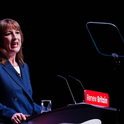Read more: Ben Bernanke's reasons to be cheerful
On Wednesday, the Federal Reserve announced the first rise in US interest rates since 2006. Back then, “Thefacebook” had just been launched by a barely known student at Harvard named Mark Zuckerberg. It was that long ago. The question as to whether the Fed has done the right thing is going to linger for a while. Importantly for us here in the UK, now that the Fed has moved, does this mean the Bank of England is likely to follow sooner than expected?
Janet Yellen, the Chair of the Federal Reserve, was at pains to emphasise that the central bank would tread a very gradual policy path. The governors of the Fed expect interest rates to rise by about 1 per cent—or 100 basis points—between now and the end of 2016, but this is a hostage to events, the economy, and especially to inflation. The Fed’s view is that the economic expansion will continue at around its current pace, low unemployment could fall even further, and inflation will rise to about 2 per cent over the medium term.
It is important to see the Fed is slightly stuck between a rock and a hard place. On the one hand the circumstances against which it has decided to kick off a tightening cycle are most unusual. On the other, the circumstances under which it cut rates to zero at the end of 2008 and implemented three rounds of asset purchases under its quantitative easing programme have clearly dissipated.
Today’s unemployment rate of 5 per cent is 0.6 per cent lower than it was in 2004 when the last tightening cycle began, but other labour market measures, such as labour force participation and the number of people marginally attached to the labour force compare less favourably. Inflation today is very low, but is only slightly lower than it was in 2004, and average hourly earnings are actually rising a little faster. Against this, though, the monetary value of GDP is growing at about 3 per cent, compared with 5 per cent in 2004, and the economy is growing just above 2 per cent, but that’s about 2 per cent less than a decade or so ago.
That’s why some people think the Fed should have waited longer. It is true, for example, that 15 of 36 OECD country central banks have raised interest rates since 2011, only to reverse the increase(s) subsequently, and in some cases, taken interest rates down to lower levels than where they began. But you could take the view—and the governors did unanimously—that the Fed has waited a considerable time already, and that there might never be a “right time” to change the monetary regime that was created after the financial crisis. Instead, economic conditions finally make a shift propitious, all things considered. Further, the longer emergency monetary conditions remain in situ for an environment that isn’t an emergency, the greater the risk of financial instability, which we have already seen in the US junk bond market and in emerging markets.
Cue the UK, and the Bank of England, for there is much about the situation facing the Fed that is similar for Mark Carney and the Monetary Policy Committee, the group within the Bank that sets interest rates. Admittedly, there are also some differences, which go a long way to explain the Bank’s reticence to follow suit. It was not always thus, of course, and the Governor’s public position on UK interest rates has swung around a few times in the last couple of years. Right now though, he and several colleagues have been clear that they see no reason to expect rates to rise any time soon. Most financial market participants don’t expect UK rates to rise until the end of 2016, or even the spring of the following year. This is very likely going to turn out to be wrong.
The UK economy is doing relatively well if, as in the US, you look at the economy and some measures of the labour market. GDP probably picked up a gear at the end of 2015, and should clock up another year of 2-2.5 per cent growth in 2016. Domestic final expenditure was actually growing at 3.5 per cent in the third quarter of this year. Record numbers of people are in work, unemployment is low at 5.2 per cent, and the most recent data for November included a welcome further fall in youth unemployment. After a long hiatus, moderate productivity growth has returned and most economists expect it to rumble on into 2016. Business investment and mortgage lending are rising, albeit from low levels in the wake of the financial crisis and recession. Household balance sheets are in slightly better shape than before the financial crisis. And George Osborne’s fiscal strategy changed in the Autumn Statement, lowering the degree of restraint over the economy.
Against all of this, you could point to the continued weakness of wage and salary formation, with data for October and November pointing to slower 2 per cent nominal growth in wages. It isn’t clear yet that productivity growth will support higher real wages for most people. There will be a technical rise in consumer price inflation because whatever happens to oil prices this winter, last year’s declines will prove to have been larger. Yet, noflation, or lowflation seems very likely to endure for a considerable time. And even though economic growth is decent enough, it is hardly running hot. So why indeed, should the Bank of England fall into line behind the Fed?
For the time being, the stand-off between the two sets of arguments looks set to prevail in favour of keeping policy rates stable. But unless or until something in the real economy tips the argument in the next several months, the key may lie in what happens to the pound. It has already dropped against a resurgent US dollar from a high of $1.71 last summer to around $1.49/1.50. We should expect more expensive holidays to the US, ie the pound is very likely to carry on falling.
Against the euro, the pound has slipped from July levels around €1.44 to about €1.37, and feels like it wants to drop further. One catalyst could be the UK’s stubbornly wide external deficit of about 5 per cent of GDP—a vulnerability that would rise in the event of a “leave” vote in the Britain’s referendum on EU membership, which will most likely take place in the middle of next year. That could end up as a car crash for the pound. Even if the vote were to stay, the pound is likely to remain our fault line next year.
I think the Bank’s thinking will change, and we will see the first cautious rise in interest rates around next May, soon after the Fed’s second rate rise. The pas de deux with the Fed will then resume.
On Wednesday, the Federal Reserve announced the first rise in US interest rates since 2006. Back then, “Thefacebook” had just been launched by a barely known student at Harvard named Mark Zuckerberg. It was that long ago. The question as to whether the Fed has done the right thing is going to linger for a while. Importantly for us here in the UK, now that the Fed has moved, does this mean the Bank of England is likely to follow sooner than expected?
Janet Yellen, the Chair of the Federal Reserve, was at pains to emphasise that the central bank would tread a very gradual policy path. The governors of the Fed expect interest rates to rise by about 1 per cent—or 100 basis points—between now and the end of 2016, but this is a hostage to events, the economy, and especially to inflation. The Fed’s view is that the economic expansion will continue at around its current pace, low unemployment could fall even further, and inflation will rise to about 2 per cent over the medium term.
It is important to see the Fed is slightly stuck between a rock and a hard place. On the one hand the circumstances against which it has decided to kick off a tightening cycle are most unusual. On the other, the circumstances under which it cut rates to zero at the end of 2008 and implemented three rounds of asset purchases under its quantitative easing programme have clearly dissipated.
Today’s unemployment rate of 5 per cent is 0.6 per cent lower than it was in 2004 when the last tightening cycle began, but other labour market measures, such as labour force participation and the number of people marginally attached to the labour force compare less favourably. Inflation today is very low, but is only slightly lower than it was in 2004, and average hourly earnings are actually rising a little faster. Against this, though, the monetary value of GDP is growing at about 3 per cent, compared with 5 per cent in 2004, and the economy is growing just above 2 per cent, but that’s about 2 per cent less than a decade or so ago.
That’s why some people think the Fed should have waited longer. It is true, for example, that 15 of 36 OECD country central banks have raised interest rates since 2011, only to reverse the increase(s) subsequently, and in some cases, taken interest rates down to lower levels than where they began. But you could take the view—and the governors did unanimously—that the Fed has waited a considerable time already, and that there might never be a “right time” to change the monetary regime that was created after the financial crisis. Instead, economic conditions finally make a shift propitious, all things considered. Further, the longer emergency monetary conditions remain in situ for an environment that isn’t an emergency, the greater the risk of financial instability, which we have already seen in the US junk bond market and in emerging markets.
Cue the UK, and the Bank of England, for there is much about the situation facing the Fed that is similar for Mark Carney and the Monetary Policy Committee, the group within the Bank that sets interest rates. Admittedly, there are also some differences, which go a long way to explain the Bank’s reticence to follow suit. It was not always thus, of course, and the Governor’s public position on UK interest rates has swung around a few times in the last couple of years. Right now though, he and several colleagues have been clear that they see no reason to expect rates to rise any time soon. Most financial market participants don’t expect UK rates to rise until the end of 2016, or even the spring of the following year. This is very likely going to turn out to be wrong.
The UK economy is doing relatively well if, as in the US, you look at the economy and some measures of the labour market. GDP probably picked up a gear at the end of 2015, and should clock up another year of 2-2.5 per cent growth in 2016. Domestic final expenditure was actually growing at 3.5 per cent in the third quarter of this year. Record numbers of people are in work, unemployment is low at 5.2 per cent, and the most recent data for November included a welcome further fall in youth unemployment. After a long hiatus, moderate productivity growth has returned and most economists expect it to rumble on into 2016. Business investment and mortgage lending are rising, albeit from low levels in the wake of the financial crisis and recession. Household balance sheets are in slightly better shape than before the financial crisis. And George Osborne’s fiscal strategy changed in the Autumn Statement, lowering the degree of restraint over the economy.
Against all of this, you could point to the continued weakness of wage and salary formation, with data for October and November pointing to slower 2 per cent nominal growth in wages. It isn’t clear yet that productivity growth will support higher real wages for most people. There will be a technical rise in consumer price inflation because whatever happens to oil prices this winter, last year’s declines will prove to have been larger. Yet, noflation, or lowflation seems very likely to endure for a considerable time. And even though economic growth is decent enough, it is hardly running hot. So why indeed, should the Bank of England fall into line behind the Fed?
For the time being, the stand-off between the two sets of arguments looks set to prevail in favour of keeping policy rates stable. But unless or until something in the real economy tips the argument in the next several months, the key may lie in what happens to the pound. It has already dropped against a resurgent US dollar from a high of $1.71 last summer to around $1.49/1.50. We should expect more expensive holidays to the US, ie the pound is very likely to carry on falling.
Against the euro, the pound has slipped from July levels around €1.44 to about €1.37, and feels like it wants to drop further. One catalyst could be the UK’s stubbornly wide external deficit of about 5 per cent of GDP—a vulnerability that would rise in the event of a “leave” vote in the Britain’s referendum on EU membership, which will most likely take place in the middle of next year. That could end up as a car crash for the pound. Even if the vote were to stay, the pound is likely to remain our fault line next year.
I think the Bank’s thinking will change, and we will see the first cautious rise in interest rates around next May, soon after the Fed’s second rate rise. The pas de deux with the Fed will then resume.












